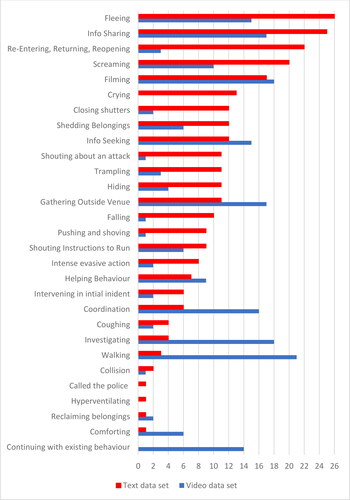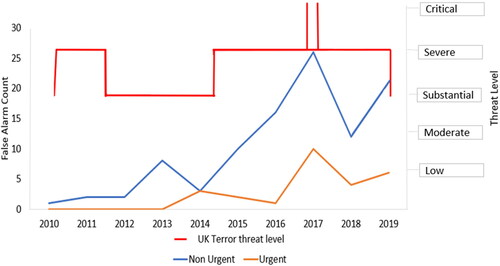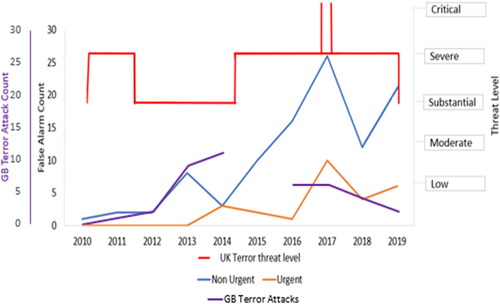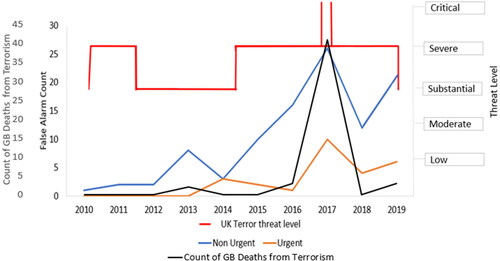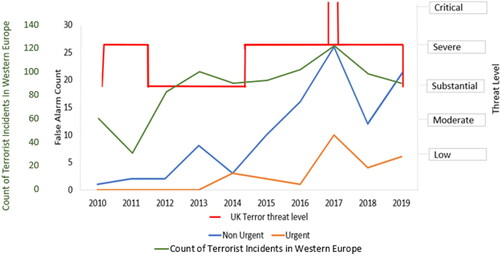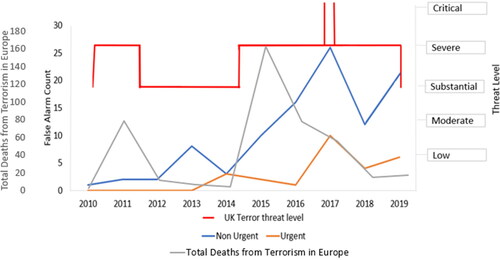Abstract
Crowd flight incidents from (mis)perceived threats are important social, psychological, and political phenomena that have been neglected in previous research. They are potentially deadly, economically disruptive, and individually distressing incidents that may result in armed police responses. Despite the seriousness of these phenomena, we know little about their occurrence in Britain. We carried out a systematic review using PRISMA principles on the Nexis media database to analyse the nature of these false alarm incidents and the relationship between false alarms and other variables, in particular real terror attacks. ‘Urgent’ crowd flight responses, often called ‘stampedes’, were found to be rare, and resulted in relatively few serious injuries. Diverse public behaviour was recorded, and competitive behaviour was relatively rare. False alarm incidents were mainly reported in locations known to be soft targets for terrorism, and incidents were associated with the National Threat Level in the second half of the decade, peaking in 2017. They were also associated with psychologically-relevant attacks in Europe, particularly indiscriminate Islamist attacks, rather than right-wing terrorism. Implications for developing a social psychological understanding of these events are discussed.
Introduction
On 24th November 2017, the busiest shopping day of the year, Black Friday, hundreds of people on London’s busiest shopping street, Oxford Street, fled from what they perceived to be a terrorist attack. London Ambulance Service reported treating sixteen people – seven were discharged at the scene, and nine were taken to hospital – as a result of injuries from what was commonly described in the media as a ‘stampede’ resulting from a ‘mass panic’ (e.g., Reynolds and Pilditch Citation2017; Simpson Citation2017). Armed police arrived in a blue light response and ordered people to hide or clear the area. Shops, bars, restaurants, and transport hubs were shut as police searched for evidence of the supposed attack or assailant. After 90 minutes the Metropolitan Police tweeted they were standing down their response. On 25th November, the BBC website reported that rather than an attack, there was a noisy altercation between two men at Oxford Circus underground station that seems to be the basis for the initial misperceptions and distress.
Research on emergencies demonstrates that risk is usually underestimated (Atwood and Major Citation2000; Kinsey et al. Citation2019; Tierney, Lindell, and Perry Citation2001). However, in some cases, as seen on Oxford Street in 2017, risk is overestimated and (mis)perceptions of hostile threats lead to urgent crowd flight responses. Around the same time, similar high-profile false alarm incidents were also reported in Paris (Bartholomew Citation2016) and Turin (Lai Citation2020). These incidents are important social, political, and psychological phenomena. They are potentially deadly (de Almeida and von Schreeb Citation2019), economically disruptive, and individually distressing incidents (Robson Citation2019a), that may result in armed police responses. Yet, they are under-researched, dismissed as mass delusions (Bartholomew Citation2016), and conflated with disparate crowd phenomena such as slow-moving crushes (Alluri et al. Citation2017). In the absence of detailed systematic research, understanding is lacking of the nature of these events: their frequency, the risks they pose, how people behave, and the conditions under which they occur. These deficits impede effective planning to respond to such incidents, including government preparedness, messaging, and forms of emergency responses. They also mean that there is an absence of theoretical understanding of the incidents. This paper addresses these gaps by conducting a systematic review of cases of collective responses to misperceived hostile threats in Britain from 2010-2019 in the Nexis news media database.
This temporal scope was chosen to insure the feasibility of the research. The geographic scope was influenced by both feasibility and the specific nature of terrorist activity in the post-conflict society in Northern Ireland (NI). NI data was excluded from the analysis for two reasons. First, only one false alarm was identified in NI despite the Nexis search including Northern Irish media. Second, the threat from terrorism in NI is of a different nature to that posed in Britain and obfuscates important variations in terrorism in Britain. (We discuss this further in the materials and methods section.)
The review addresses two central questions; (i) what is the nature of these false alarm events? and (ii) What is the relationship between these incidents and real terror attacks?
Understanding the nature of false alarm flight incidents
Dramatic false alarm incidents involving crowd flight such as those in Oxford Street in 2017 are often labelled ‘stampedes’ caused by ‘mass panic’ (e.g., Perring Citation2017, Littlejohn Citation2017). However, this characterization is problematic for understanding the nature of false alarm flight incidents.
First, the literature on ‘stampedes’ covers a variety of crowd behaviour including running from a threat and towards a goal (Burkle and Hsu Citation2011; Salamati and Rahimi-Movaghar Citation2016) and relatively static (or slow moving) crushes and crowd collapses (Benedictus Citation2015; Ngai et al. Citation2009; Alluri et al. Citation2017; de Almeida and von Schreeb Citation2019). Conflating disparate incidents obscures their causes, impeding effective prevention and intervention.
Second, even where the term ‘stampedes’ refers to running incidents, these are characteristically defined as ‘impulsive’ surges (see de Almeida and von Schreeb Citation2019 for comparisons of definitions). Unlike the more neutral term ‘flight’, the term ‘stampede’ presumes the psychology, and more properly belongs to the instinctive behaviour of animals rather than people (Cocking Citation2013).
Third, the problem of understanding flight as caused by irrational mass panic (e.g., Helbing, Farkas, and Vicsek Citation2000; Wieringa Citation2015; Salamati and Rahimi-Movaghar Citation2016; Perring Citation2017, Littlejohn Citation2017) is that the rationality or otherwise of a given behaviour in an emergency is inherently difficult to judge (Bartolucci, Casareale, and Drury Citation2021). Running has been noted as an undesirable risky behaviour in evacuations (van der Wal et al. Citation2021; Kobes et al. Citation2010; Proulx and Sime Citation1991; Shiwakoti et al. Citation2020). However, the risks posed by running – such as falls and collisions – can only be understood alongside the risk posed by the external threat. In the context of a perceived Marauding Terrorist Attack (MTA), running may be an appropriate response (Kvamme Citation2017). Indeed, this is precisely the behaviour encouraged by British government messaging like the ‘Run Hide Tell’ campaign (NaCTSO (National Counter Terrorism Security Office) Citation2015; Pearce et al. Citation2019). In situations of uncertainty, it might make sense to ‘err on the side of caution’ – by running away.
Finally, ‘mass panic’ explanations suggest that people primarily engage in uncontrolled selfish behaviours. Yet the disasters and emergencies research literature note a diversity of public behaviour during emergencies, much of it cooperative (e.g., Prati, Catufi, and Pietrantoni Citation2012; Wessely Citation2017; Philpot and Levine Citation2022; Bartolucci, Casareale, and Drury Citation2021). The variety observed suggests behaviour is chosen (rather than instinctive) and therefore controlled. This challenges assumptions of widespread, impulsive, selfish behaviour inherent in mass panic induced stampede explanations of crowd flight.
Accordingly, an accurate, evidence-based understanding of collective flight responses to misperceived hostile threats that goes beyond ‘stampedes’ and ‘mass panic’ discourse is required. Central to this requirement is an understanding of public perceptions of risk.
The relationship between false alarms and real terror attacks
In the British context, recent examples of crowd flight to false alarms occurred prima facie in relation to the threat from terrorism (Simpson Citation2017; Bond, Macaskill, and White Citation2017). As such, there is an assumed (causal) relationship between the genuine risk from terrorism and collective flight responses to misperceived threats.
Informed by expected utility theory, researchers and practitioners in applied settings seek to quantify objective risk through likelihood x magnitude matrices (Duijm Citation2015). This is our starting point for analysing the relationship between false alarms and terror attacks.
To understand the likelihood of an event occurring in the future it is instructive to look at how frequently it occurred in the past. The Oxford Street and Paris false alarm incidents took place in the aftermath of deadly terror attacks in England and France. A simple reading of these events is that public (mis)perceptions of hostile terrorist threats increase when the frequency of terror attacks increase.
The second aspect of risk in expected utility theory is magnitude or severity. The frequency of an attack may be less important for informing perceptions of risk than the severity of attack – that is, how many people are killed.
Risk perception is dynamic (Loewenstein and Mather Citation1990) and is affected by media and government messaging (Wormwood et al. Citation2016; Pearce et al. Citation2019). MI5’s website states that changes in the Joint Terrorism Analysis Centre’s (JTAC) assessment of the terror threat level do not require specific public responses. However, increases in the threat level are often accompanied by government statements, such as those reported on the BBC news website on 29 August 2014 and 3rd November 2020. Furthermore, the threat level provides the context for news media articles (O’Callaghan Citation2017; Greenfield, Cobain, and Dodd Citation2017). As such, it is a key component in British government communications with the public about risks from terrorism.
Beyond the magnitude and frequency of risk, group membership has been argued to have an important influence on risk perception over a range of risks (Wildavsky and Dake Citation1990, Spears Citation2010) including terrorism (Williamson Citation2019). The indiscriminate nature of Islamist MTAs compared to the targeting of minorities by far-right terrorists means the risk of terrorist attacks varies for different groups in Britain. Given the ‘Clash of civilisations’ framing of the ‘War on Terror’ (Sian, Law, and Sayyid Citation2012; Sultan Citation2016), and the relatively recent acknowledgement of the risks of Far-Right terrorism, (Home Office Citation2018), public perceptions of the risk of terrorism in Britain are likely to be dominated by the threat from Islamist terrorism. This suggests there is an important role for assessments of group based self-relevance in understanding public perceptions of risks from terrorism beyond frequency and magnitude of attack.
The current study
In the absence of academic research on collective flight responses to (mis)perceived threats in Britain, we used a comprehensive search of news media sources to identify incidents. Two central research questions were addressed; (i) What is the nature of these false alarm incidents? and (ii) What is the relationship between false alarms and real terror attacks?
To address question one, we characterized incidents on a number of features: when and where they took place, how people behaved, and injuries sustained. News media articles and contemporaneous video clips pertaining to incidents where crowds ran were coded for public behaviours. A codebook was developed from Philpot and Levine (Citation2022) video analysis of a train evacuation and evolved to accommodate behaviours at each incident.
To address question two, we analysed the location of false alarms. Then through a series of graphs we compared the frequency of false alarms in Britain with: (1) the UK National Threat Level; (2) the frequency and magnitude of terrorist attacks in Great Britain (GB) and Western Europe; and (3) terrorist ideology behind Western European attacks.
Materials and methods
Identifying incidents
A Google search scoping exercise revealed 12 separate incidents in Britain between 2015 and 2020 that were prima facie consistent with our definition of the phenomenon under investigation – collective flight response from a misperceived threat. This suggested that analysing the 10-year period 2010-2019 within Britain would both be feasible and provide sufficient variability to analyse potential patterns meaningfully. PRISMA principles and processes (Page et al. Citation2021) were adapted and applied to the Nexis database, a comprehensive newspaper database providing full text access to UK national newspapers, to produce a systematic, transparent search.
The search string False AND Alarm AND (Crowds OR Stampede OR Flee OR Fled OR Panic) was informed by the initial scoping exercise. After specifying our search string, we used Nexis filters to narrow the search to include only UK news media (including Northern Irish media). This search produced 10,000+ articles. The search was further narrowed geographically to Europe (10,000+ articles), Northern Europe (8,663 articles), then to the UK (8,467 articles). The timeline was then narrowed to 1st January 2010 to 31st December 2019 (5,250 articles). High similarity duplicates were grouped by Nexis, leaving 5,146 articles for screening. Headlines were screened for relevance to the study’s focus: collective flight responses to misperceived threats. Excluding 4736 irrelevant articles left 410 articles to be screened. Further screening of these articles to exclude real attacks, articles with insufficient crowd behaviour reporting, unreliable speech to text translations, further duplicates, and non-British incidents, left 169 eligible articles from the Nexis search.
Articles often contextualised the incidents by referring to other similar incidents. Further follow-up searches identified articles to both triangulate data from the Nexis search and identify articles on newly discovered incidents. The search term for the follow-up searches was the incident location, venue, and date. Follow-up searches revealed 457 further eligible articles. In total 626 articles were included in the analysis ().
Figure 1. PRISMA flow chart (Page et al. Citation2021) adapted for identifying crowd flight articles.
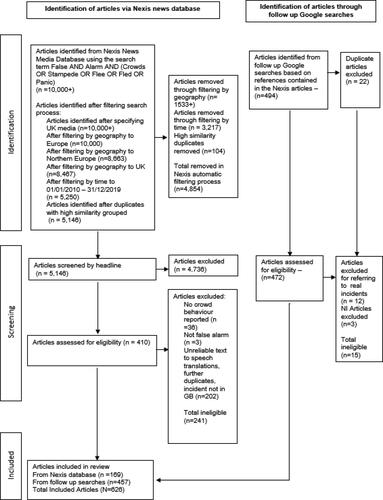
The nature of crowd flight incidents
Content analysis of the 626 articles revealed 126 incidents. Details such as date, location, injuries, emergency service response, and proximal cause of crowd flight were recorded in an Excel spreadsheet (where data was available). Some sensationalist headlines using ‘panic’ implied running, but lacked behavioural descriptions of collective running and instead appear to refer to e.g., travel disruption. Other articles featured clear reports of collective running from a perceived threat. Where articles featured clear behavioural reports of collective running, we sought confirmation of these reports through cross-referencing other articles on the same incident. Where cross-referencing with other articles confirmed initial behavioural reports of collective running, we categorized those incidents as ‘urgent’. Incidents without clear behavioural descriptions of collective running or where cross-referencing was impossible were categorized as ‘non-urgent’.
Public behaviour in the ‘urgent’ incidents was the basis of further in-depth content analysis of the text and video clips accompanying the articles (Erlingsson and Brysiewicz Citation2013). One incident was redesignated a ‘non-urgent’ incident after content analysis of seven relevant articles revealed only two mentioned running, both citing the same tweet, while accompanying video clips also failed to demonstrate collective running. This left 26 ‘urgent’ incidents (250 articles and 124 video clips).
The video coding form consisted of ‘urgent’ incident clips broken down into 10 second intervals. The presence of a behaviour was checked in the corresponding cell. News articles on the ‘urgent’ false alarm incidents underwent content analysis in NVivo 12. Both inductive and deductive approaches to coding were used (Rivas Citation2012). A coding handbook was initially constructed using codes from Philpot and Levine (Citation2022) (fleeing, investigating, freezing, continuing activities, recovering belongings, competitive and anti-social behaviour, searching for or helping others, and seeking information). As the data were coded, behaviours and definitions in the codebook were added and refined, resulting in the final codebook included in the Supplementary Materials.
Inter-rater reliability tests using Cohen’s κ were conducted on the coding. The third author, who had not been involved in the analysis, was trained in the final version of the behavioural codebook, use of the coding form and NVivo. Text from news articles relating to three incidents (11.5% of ‘urgent’ incidents) were then coded by the third author and compared against the primary coder’s coding. Clips covering a further three incidents (11.5% of ‘urgent’ incidents) were also video coded by the third author and again compared to the primary coders coding. The agreement percentage for the text data set was 81%, and the κ was .79. The agreement percentage for the video data set was 74%, and the κ was .72 both are considered substantial (Landis and Koch Citation1977) or good (Fleiss Citation1981).
The relationship between false alarms and terror attacks
The second research question addressed the possible relationship between terror attacks and false alarm incidents. First, the places (cities/towns) and locations (transport hubs, shopping centres, stadiums etc.) of false alarms were compared to real terror attacks. Next, through a series of graphs, the yearly rate of ‘urgent’ and ‘non-urgent’ false alarm incidents were compared to the JTAC assessed National Threat Level, and the frequency, and then severity of real terror attacks in Britain. These comparisons were repeated for Western Europe, with the additional dimension of the attackers’ ideology included in the comparison.
As the available Global Terrorism Database (START (National Consortium for the Study of Terrorism and Responses to Terrorism) 2019) only ran up until 2018, we combined this data with data from the EU Terrorism Situation Report (2020) and data obtained (via email on 6th January 2021) from the Police Service of Northern Ireland (PSNI), to complete the dataset of real terrorist incidents for comparison with false alarms. This data set can be found in the Supplementary Materials.
Northern Ireland (NI) data was excluded from the analysis for two reasons. The first is that the Nexis search only identified one false alarm in Northern Ireland, despite including Northern Irish media. Intentional bomb-scares are relatively common in NI; for example, there were 363 hoax bomb alerts in 2010 and 339 in 2011 (Police Service of Northern Ireland Citation2012). One possible explanation for the lack of results in our Nexis search is that people in NI have become habituated to these incidents. Another is that false alarms are less newsworthy in a post conflict society where incidents of actual terrorist activity are plentiful.
Secondly, as evident in the Supplementary Materials, the large number of terrorist incidents masks important variation between the relatively low frequency of terror incidents in Britain and false alarms. The single false alarm identified and the different nature of terrorist threat was considered to obscure the analysis, and so NI data was therefore excluded.
Results
On the nature of crowd flight incidents
The first research question concerned the nature of crowd flight from misperceived threats in Britain, 2010–2019. We found that these events were relatively rare. Out of 126 false alarm incidents over 10 years we identified 26 ‘urgent’ crowd flight incidents, defined by groups of people running from misperceived threats.
Injuries
Reported injuries from crowd flight were rare. More reported injuries resulted from the cause of the crowd flight incident (e.g., fights, exploding batteries, a car accident) rather than running. Four of the ‘urgent’ false alarm incidents resulted in nineteen injuries from crowd flight, sixteen were from just one incident ().
Table 1. Injuries from ‘urgent’ false alarm incidents.
Behaviour
The nature of the study precludes strong statements on the prevalence of behaviour at each incident. Instead, the number of incidents that each behaviour was noted at is displayed in . These behaviours are defined in the Supplementary Materials. We will not comment on each behaviour. Instead, we offer three observations.
First, a diverse range of behaviours was noted in the urgent crowd flight incident datasets. While some people did run from misperceived threats, not everyone did. Many walked away without much urgency, others stopped and filmed, others investigated the reason for the commotion. In some cases, people intervened in the apparent sources of threat, such as a fight or a fire.
Second, less than half the incidents featured competitive behaviours like pushing and trampling. Incidents where people engaged in intense evasive actions such as vaulting escalators were also rare.
Third, the articles and video data sources diverged somewhat. Running, screaming, crying, and shouting about an attack featured in text more than in videos. Competitive behaviours such as pushing and trampling also featured in text more than videos.
Relationship to terror attacks
Where do false alarm incidents occur?
shows London and Manchester saw the most ‘urgent’ and ‘non-urgent’ false alarms. The high-profile terror attacks in Manchester and London, particularly in 2017 suggest an association between where terror attacks occur (or are perceived to occur) in Britain and false alarms.
Table 2. Cities and towns where false alarm incidents occurred.
An association between terror attacks and false alarm incidents was also observed in analysis of the specific location of false alarm incidents. shows transport hubs and shopping centres were the most common locations for urgent incidents. As reported by the BBC on 1st January 2019 a transport hub was subject to an MTA in Manchester while another later occurred in a Manchester shopping centre (Robson Citation2019b).
Table 3. Locations where false alarms occurred.
Do false alarm incidents relate to the national threat level?
There is some evidence that false alarm incidents were (imperfectly) associated with the UK national terror threat level throughout 2010-2019. shows a strong association across 2015-2019. After a small peak in ‘non-urgent’ false alarm incidents in 2013, a sustained increase in the frequency of false alarms began in 2014/2015 with both ‘urgent’ and ‘non-urgent’ incidents peaking in 2017, dipping in 2018, before another increase in 2019. The UK national threat level was raised in July 2014 and peaked twice at the ‘critical’ level briefly in 2017 before returning to ‘severe’ where it was sustained until 4th November 2019.
Do false alarm incidents relate to the frequency of terror attacks in GB?
A partial association between the frequency of false alarms and terror attacks in GB was observed – see . A small peak in ‘non-urgent’ false alarms occurred in 2013 coinciding with an increase in real attacks. ‘Urgent’ false alarm incidents increased in 2014 as real terror attacks continued to increase. False alarms continued rising in 2015 despite there being no terror attacks that year. While the 2017 peak of false alarms followed several real attacks that year, there were in fact five more real attacks in 2014 than in 2017, yet the number of false alarms in 2014-15 was much lower than in 2017.
Do false alarm incidents relate to the magnitude of attacks in GB?
illustrates a relatively strong association between false alarm incidents and the magnitude of terror attacks (as measured by the number of dead). Peaks in the number of people killed in terror attacks and false alarms were observed in 2013, 2017 and 2019. The 2013 peaks occurred during a relatively low national threat level assessment while 2017 saw the highest national threat level.
Do false alarms relate to the frequency of terrorist attacks in Western Europe?
Analysis of the frequency of terror attacks in Europe visualized in shows two peaks. After a dip in 2012, a 2013 peak coincided with a small peak in ‘non-urgent’ false alarms while the UK terror threat level was relatively low. A second peak in 2017 coincided with the peak in GB false alarms, deaths, and the highest terror threat level.
Do false alarms relate to the magnitude of attack in Europe?
The most severe terrorist attacks in Europe occurred in 2015 and 2011. The large number of deaths in 2015 is associated with a significant increase in false alarms in GB in 2015, and follows an increase in the national threat level in August 2014. However, 2011 also saw a large number of deaths from terror attacks, yet this appears to have little association with false alarm incidents nor the UK national terror threat level ().
Do false alarms relate to the ideology behind deadly attacks in Europe?
To summarize thus far, while there was some relation, neither the frequency nor magnitude of terror attacks in Western Europe were consistently associated with the observed pattern of false alarms in GB. However, examining the ideology of the attacks suggests an association with some attacks and not others. Specifically, false alarms followed the Islamist attacks in 2015 but not Breivik’s 2011 right-wing attack despite the very high severity of the latter (77 deaths, many of them children) ().
Figure 8. Comparing false alarms and the national terror threat level in GB, and the magnitude and ideology of European terror attacks.
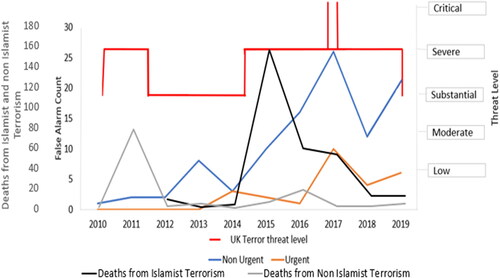
A variety of ideological groups also committed attacks; however, Breivik’s attack most resembled Islamist MTAs which were associated with increased false alarm incidents. The absence of false alarm incidents following Breivik’s attack suggests the importance of group-based relevance in public perceptions of the risk of terrorism, beyond frequency and magnitude.
Discussion
Our systematic review of collective flight responses from misperceived threats in Britain 2010-2019 identified 126 incidents, which comprised 26 ‘urgent’ crowd flight incidents, involving groups of people running, and 100 ‘non-urgent’ incidents (without running). Analysis of ‘urgent’ incidents, revealed diverse public behaviours, including both competitive and cooperative behaviour. Reports of injuries from crowd flight were rare. False alarm incidents were associated with an elevated official national terror threat level between 2014-2019. False alarms occurred in cities and locations either previously targeted or known soft targets. False alarms were only partly associated with the frequency of terror attacks in Britain overall; but peaks in frequency of false alarms in 2017 coincided with peaks in the magnitude of terror attacks in Britain (as measured by the number of deaths). The sustained increase in reports of false alarm incidents in Britain in 2015 were associated with IS attacks in Europe in 2015 (but not with right wing attacks despite their magnitude).
Here we discuss how our findings challenge ‘mass panic’ explanations of ‘urgent’ crowd flight. We interpret the increased number of false alarm incidents as evidence of increased public perception of the risk of terrorism which was calibrated to the occurrence of terrorist attacks. The pattern points to the importance of intergroup relations in understanding public perceptions of risk, suggesting areas for further research.
On the nature of crowd flight incidents
‘Mass panic’ explanations of ‘stampedes’ suggest widespread uncontrolled mindless movement of an impulsive crowd (Alluri et al. Citation2017; Quarantelli Citation2001). However, we found ‘urgent’ crowd flight to be rare. Where collective running behaviour was evident, it was not as widespread nor uncontrolled as mass panic suggests. A considerable degree of diversity of behaviours was noted. Not everyone ran; some walked, others investigated what was happening, while others filmed the unusual event.
Explanations of crowd behaviour in terms of panic suggest selfish competitive behaviour is widespread. However, consistent with findings from real emergency evacuations (Bartolucci, Casareale, and Drury Citation2021; Kvamme Citation2017), our analysis found that competitive behaviours such as pushing and trampling were relatively rare, and noted the presence of cooperative behaviours such as coordination, helping, and comforting.
While running during emergency evacuation has been noted as a risk behaviour (van der Wal et al. Citation2021; Kobes et al. Citation2010; Shiwakoti et al. Citation2020), we found the risk of injury to individuals from running to be relatively low. Injuries from crowd flight were concentrated in the largest incident on Oxford Street 2017, and these were mainly minor and small in number. Most recorded injuries were as a result of the initial incidents that precipitated crowd flight (e.g., car crash, exploding batteries, or fights).
Since 2015, British government advice on how to deal with a Marauding Terrorist Attack incident is primarily to run (NaCTSO (National Counter Terrorism Security Office) Citation2015; CPNI (Centre for the Protection of National Infrastructure) Citation2018; Pearce et al. Citation2019). Indeed, in one case reviewed here police advice was to ‘run and don’t stop running’ (Bosotti Citation2017). As the risk from running behaviour appears to be low, and is in some cases recommended by authorities, it is not clear that crowd flight is irrational behaviour. Indeed, as Kvamme (Citation2017, 7) notes, ‘flight… can be rational in a disaster situation’. A Marauding Terrorist Attack could constitute such a disaster situation.
On the relationship with real terror attacks
The observed association between threat level and false alarms suggests a link between public perceptions of the risk from terrorist attack and security agency assessed risk of terrorist attack. However, the association only holds between 2015-2019. False alarms were not common in 2010 when the threat level was elevated and small peaks in false alarms were seen in 2013 and 2014 when the threat level was lowest. This suggests the public are not simply responding to JTAC assessments.
This difference in public responses at different time points may be explained by the increasing use of MTAs. The unsophisticated nature of these attacks require no specialist skills or equipment, making them particularly dangerous, as anyone could attack anywhere. The uncontrollable nature of these potentially catastrophic events is associated with increased risk perception (Slovic, Fischhoff, and Lichtenstein Citation1981; Loewenstein and Mather Citation1990; Pearce et al. Citation2019). Furthermore, as British government advice on recognising an MTA states ‘Often the first indication of an attack is people moving in the same direction forming a large crowd.’ (CPNI (Centre for the Protection of National Infrastructure) Citation2018, 9), MTAs are particularly relevant to crowd flight.
Increasing MTAs in Europe in 2015 (Europol Citation2016) led to a reassessment of the nature of the terrorist threat in Britain. Government advice to the public was recalibrated and distributed on film (NaCTSO (National Counter Terrorism Security Office) Citation2015). Harris’s (Citation2016, 6) independent review of London’s preparedness to respond to a major terror incident considered marauding attacks to now be ‘the new normal, particularly for attacks inspired by the so-called Islamic State’. The increased number of false alarms from 2015-2019 arguably reflects this ‘new normal’ and may help explain the relative lack of false alarms despite the raised national threat level 2010- July 2011.
Consistent with Loewenstein and Mather (Citation1990) finding that, in some cases, public perceptions of risk are surprisingly accurate reflections of objective risk, both false alarms and the risk of dying in a terror attack in GB peaked in 2017. Furthermore, false alarms were most common where MTAs occur. Indeed, on the 1st January 2019 the BBC reported an MTA in a Manchester railway station while another later occurred in a Manchester shopping centre (Robson Citation2019b). Therefore, in a challenge to ‘mass panic’ explanations of irrational, impulsive, ‘stampedes’, the pattern of false alarm crowd flight incidents suggest public perceptions of the risk of terrorist attack are calibrated to the frequency and location of actual attacks.
The sustained increase in false alarms from 2015 was not straightforwardly associated with greater frequency or more severe attacks in Britain. However, it did occur at the same time as particularly severe attacks in Europe. This evidence, and the association between false alarms and Islamist attacks (but not right-wing attacks), points to the importance of considering how the attacks were construed in relation to collective identities in Britain.
Our data only permits speculation on this point; however, this speculation is consistent with arguments that risk perception is not only influenced by the magnitude and frequency of risk, but is also a function of group membership (Wildavsky and Dake Citation1990; Spears Citation2010; Williamson Citation2019). As reported on the BBC website on 11th January and 17th November 2015, numerous solidarity demonstrations were held in Britain following high-profile terror attacks in France. The demonstrations emphasised a shared identity associated with attack from a common enemy (Bauer et al. Citation2016; cf. Drury Citation2018). They reflected online solidarity campaigns such as ‘Je suis Charlie’, reported on the BBC website on 3rd January 2016, and Facebook’s French flag campaign (Feeny Citation2015) which also emphasised a shared identity. As reported on the BBC website on 3rd December 2015, this common identity was formalised militarily as Britain joined France in bombing Syria, providing an official common enemy in IS. The attacks in France were salient, shockingly severe, and self-relevant to people in Britain. As such, they arguably contributed to increased public perceptions of risk which was reflected in the increase in false alarm reports.
Breivik’s 2011 attacks in Norway were also shocking and severe. The Utøya attack was also a marauding terrorist attack. However, despite links between Breivik and the English Defence League (Taylor Citation2011), the attack was arguably not as self-relevant for most people in Britain. Breivik’s attack was discussed less on social media by news agencies (Roman, Alkazemi, and Stewart (Citation2020). It did not fit easily into ‘Clash of civilisations’ discourse prevalent in British media (Sian, Law, and Sayyid Citation2012; Sultan Citation2016). These factors arguably meant Breivik’s attacks were not construed as an attack on an ingroup including British citizens. Accordingly, it was not associated with an increase in crowd flight.
Strengths and limitations
A strength of this paper is the use of two types of data (news reports and contemporaneous video) to both produce convergent evidence and spot divergence. While there are limitations in using media sources in terms of media interests, sensationalism, and framing, the combination of sources provided insight into the nature and possible predictors of false alarm incidents.
Our search term did not specifically mention terrorism. This can be viewed as a strength of the paper. It provides confidence that the association observed between false alarms and terrorist attacks are not simply a consequence of our search process.
The exclusion of NI incidents is a limitation. It is possible that there are meaningful regional differences as a result of habituation to hoaxes and actual attacks. However, without further in-depth analysis of subjective experiences we are unable to assert this confidently.
It should also be noted that, as media reports are skewed towards more sensational incidents, it is likely that incidents without group running behaviour were vastly underestimated.
Future research
Further research should interview those involved in false alarm incidents to understand the subjective experiences in greater detail. Further analysis should seek to analyze more comprehensive datasets (e.g., contemporaneous clips and interviews) in detailed case studies that can speak authoritatively to the specific dynamics and subjective experiences of why people run from (mis) perceived threats.
Further analyses should analyse how powerful groups such as emergency services contribute to unfolding dynamics of these intergroup situations. Shirado, Crawford, and Christakis (Citation2020, 13) found that communication within networks during emergencies ‘may work poorly as information pathways for inconvenient truths’ noting that ‘In the absence of information, people spontaneously generate rumours, and networks can magnify this’ (11). The need for accurate authoritative information to reduce uncertainty is clear. Further research should examine how people, especially those in authority, communicate information about risk (Proulx and Sime Citation1991).
One explanation for why few injuries were observed in the incidents reviewed in this analysis may be that they were generally smaller scale incidents with less sustained running. Further research should examine the specific conditions such as scale and opportunity for escape in individual incidents in greater detail (e.g., Turin, where 3 people died as a result of injuries sustained in a large crowd flight incident which began in a relatively enclosed square (Lai Citation2020).
The media has a central role in informing our collective fears (Nickels et al. Citation2012; Breen-Smyth Citation2014). Competitive behaviour was more common in news articles than videos, whereas cooperative behaviour was more common in video clips than text. This imbalance in favour of reporting sensational competitive behaviours suggests media bias perpetuates myths of mass panic. Future research should examine the role of the media in shaping collective fears by getting participants’ self-reported emotions, not just observations of how they behaved in these incidents.
These results are specific to Britain. The lack of Northern Irish incidents highlights the differences in threats faced throughout the world. Further research should examine incidents in places where different threats are faced. - For example, in the US, where the identities of ingroup and outgroup are different than the British situation, where guns are used more frequently, there have been both ‘active shooter’ attacks and a number of ‘urgent’ false alarm incidents, some of them at music festivals.
Conclusions
The present analysis has made an empirical contribution in identifying and characterising false alarm incidents and analysing public behaviour in ‘urgent’ crowd flight incidents. ‘Urgent’ crowd flight incidents, sometimes known as ‘stampedes’, are relatively rare in Britain. Public behaviour in false alarms is diverse. Competitive behaviour is rare and appears to be influenced by environmental constraints. Crowd flight has resulted in relatively few injuries. The review observed associations between psychologically relevant terror attacks and false alarms suggesting the importance of identity content in public perceptions of risk. These findings challenge mass panic accounts of crowd flight.
Disclosure statement
No potential conflict of interest was reported by the author(s).
Correction Statement
This article has been republished with minor changes. These changes do not impact the academic content of the article.
Additional information
Funding
References
- Alluri, S., A. Voskanyan, R. Sarin, M. Molloy, and G. Ciottone. 2017. “It’s a Crush… It’s a Collapse… It’s… Wait, That’s No Stampede!.” Prehospital and Disaster Medicine 32 (S1): S27–S28. doi:https://doi.org/10.1017/S1049023X17000929.
- Atwood, L. E., and A. M. Major. 2000. “Optimism, Pessimism, and Communication Behavior in Response to an Earthquake Prediction.” Public Understanding of Science 9 (4): 417–432. doi:https://doi.org/10.1088/0963-6625/9/4/305.
- Bartholomew, R. E. 2016. “The Paris Terror Attacks, Mental Health and the Spectre of Fear.” Journal of the Royal Society of Medicine 109 (1): 4–5. doi:https://doi.org/10.1177/0141076815625070.
- Bartolucci, A., C. Casareale, and J. Drury. 2021. “Cooperative and Competitive Behaviour among Passengers during the Costa Concordia Disaster.” Safety Science 134. 105055. doi:https://doi.org/10.1016/j.ssci.2020.:.
- Bauer, M., C. Blattman, J. Chytilová, J. Henrich, E. Miguel, and T. Mitts. 2016. “Can War Foster Cooperation?” Journal of Economic Perspectives 30 (3): 249–274. doi:https://doi.org/10.1257/jep.30.3.249.
- Benedictus, L. 2015. “Hajj Crush: how Crowd Disasters Happen, and How They Can Be Avoided.” The Guardian 3rd October.
- Bond, A., G. Macaskill, and V. White. 2017. “Panic at the Arndale: Screaming and in Tears, Hundreds Flee Manchester Shopping Centre After ‘Big Bang’”. Mirror, May 23. https://www.mirror.co.uk/news/uk-news/manchester-arena-bomb-arndale-centre-10481402
- Bosotti, A. 2017. “‘Run and DON’T STOP’ Witness describes moment police evacuated the Natural History Museum”. Express. 7th October. https://www.express.co.uk/news/uk/863532/London-car-museum-exhibition-road-incident-today-eyewitness-news-now-video.
- Breen-Smyth, M. 2014. “Theorising the “Suspect Community”: Counterterrorism, Security Practices and the Public Imagination.” Critical Studies on Terrorism 7 (2): 223–240. doi:https://doi.org/10.1080/17539153.2013.867714.
- Burkle, F. M., and E. B. HsuJr. 2011. “Ram Janki Temple: Understanding Human Stampedes.” Lancet (London, England) 377 (9760): 106–107. doi:https://doi.org/10.1016/S0140-6736(10)60442-4.
- Cocking, C. 2013. “Crowd Flight in Response to Police Dispersal Techniques: A Momentary Lapse of Reason?” Journal of Investigative Psychology and Offender Profiling 10 (2): 219–236. doi:https://doi.org/10.1002/jip.1389.
- CPNI (Centre for the Protection of National Infrastructure). 2018. Marauding Terrorist Attacks: Supplementary Guidance - Preparing Personnel. https://www.cpni.gov.uk/marauding-terrorist-attacks-1
- de Almeida, M. M., and J. von Schreeb. 2019. “Human Stampedes: An Updated Review of Current Literature.” Prehospital and Disaster Medicine 34 (1): 82–88. doi:https://doi.org/10.1017/S1049023X18001073.
- Drury, J. 2018. “The Role of Social Identity Processes in Mass Emergency Behaviour: An Integrative Review.” European Review of Social Psychology 29 (1): 38–81. doi:https://doi.org/10.1080/10463283.2018.1471948.
- Duijm, N. 2015. “Recommendations on the Use and Design of Risk Matrices.” Safety Science 76: 21–31. doi:https://doi.org/10.1016/j.ssci.2015.02.014.
- Erlingsson, C., and P. Brysiewicz. 2013. “Orientation among Multiple Truths: An Introduction to Qualitative Research.” African Journal of Emergency Medicine 3 (2): 92–99. doi:https://doi.org/10.1016/j.afjem.2012.04.005.
- Europol. 2016. European Union terrorism situation and trend report (TE-SAT). Accessed July 20, 2016. https://www.europol.europa.eu/sites/default/files/documents/europol_tesat_2016.pdf
- Feeny, F. 2015. “Facebook’s New Photo Filter Lets You Show Solidarity With Paris”. Time November 14. https://time.com/4113171/paris-attacks-facebook-filter-french-flag-profile-picture/
- Fleiss, J. L. 1981. Statistical Methods for Rates and Proportions. 2nd ed. New York: John Wiley.
- Greenfield, P., I. Cobain, and V. Dodd. 2017. Oxford Street Panic Began with Fight at Tube Station, Suggest Police. The Guardian. 24th November 2017. https://www.theguardian.com/uk-news/2017/nov/24/oxford-circus-police-attend-tube-incident
- Harris, T. Lord. 2016. “An Independent Review of London’s Preparedness to Respond to a Major Terrorist Incident.” https://www.london.gov.uk/sites/default/files/londons_preparedness_to_respond_to_a_major_terrorist_incident_-_independent_review_oct_2016.pdf
- Helbing, D., I. Farkas, and T. Vicsek. 2000. “Simulating Dynamical Features of Escape Panic.” Nature 407 (6803): 487–490. doi:https://doi.org/10.1038/35035023.
- Home Office. 2018. ‘Contest: The United Kingdom’s Strategy for Countering Terrorism’. https://assets.publishing.service.gov.uk/government/uploads/system/uploads/attachment_data/file/716907/140618_CCS207_CCS0218929798-1_CONTEST_3.0_WEB.pdf
- Kinsey, M. J., S. M. V. Gwynne, E. D. Kuligowski, and M. Kinateder. 2019. “Cognitive Biases within Decision Making during Fire Evacuations.” Fire Technology 55 (2): 465–485. doi:https://doi.org/10.1007/s10694-018-0708-0.
- Kobes, M., I. Helsloot, B. de Vries, J. G. Post, N. Oberij´e, and K. Groenewegen. 2010. “Way Finding during Fire Evacuation; an Analysis of Unannounced Fire Drills in a Hotel at Night.” Building and Environment 45 (3): 537–548. doi:https://doi.org/10.1016/j.buildenv.2009.07.004.
- Kvamme, V. 2017. Use of Behavioral Theories for the Interpretation of Human Behavior in the Costa Concordia disaster. Sweden: Department of Fire Safety Engineering Lund University.
- Lai, F. 2020. “Tragedia di piazza San Carlo, morto un altro dei feriti: è il terzo.” La Stampa, February 18. https://www.lastampa.it/torino/2020/02/18/news/tragedia-di-piazza-san-carlo-morto-un-altro-dei-feriti-e-il-terzo-1.38483935.
- Landis, J. R., and G. G. Koch. 1977. “The Measurement of Observer Agreement for Categorical Data.” Biometrics 33 (1): 159–174. doi:https://doi.org/10.2307/2529310. JSTOR 2529310. PMID 843571.
- Littlejohn, R. 2017. “An A-Bomb in Wardour Street: Don’t Panic! Richard Littlejohn asks Why People Fleeing Oxford Circus Found Time to Update their Social Media.” The Daily Mail, November 27. https://www.dailymail.co.uk/debate/article-5123255/An-bomb-Wardour-Street-Dont-Panic.html.
- Loewenstein, G., and J. Mather. 1990. “Dynamic Processes in Risk Perception.” Journal of Risk and Uncertainty 3 (2): 155–175. doi:https://doi.org/10.1007/BF00056370. doi:https://doi.org/10.1111/j.1468-2958.2002.tb00826.x.
- NaCTSO (National Counter Terrorism Security Office). 2015. Stay Safe. https://www.gov.uk/government/publications/stay-safe-film.
- Ngai, K. M., F. M. Burkle, A. Hsu, and E. B. Hsu. 2009. “Human Stampedes: A Systematic Review of Historical and Peer-Reviewed Sources.” Disaster Medicine and Public Health Preparedness 3 (4): 191–195. doi:https://doi.org/10.1097/DMP.0b013e3181c5b494.
- Nickels, H. C., L. Thomas, M. J. Hickman, and S. Silvestri. 2012. “Constructing Suspect Communities and Britishness: Mapping British Press Coverage of Irish and Muslim Communities 1974–2007.” European Journal of Communication 27 (2): 135–151. doi:https://doi.org/10.1177/0267323112445604.
- O’Callaghan, L. 2017. ‘Is It Safe to Travel to London? Latest Update After Incident Near Natural History Museum’. Express 7th October 2017. https://www.express.co.uk/travel/articles/863566/london-latest-travel-advice-update-car-crash-terror-fears
- Page, M. J., J. E. McKenzie, P. M. Bossuyt, I. Boutron, T. C. Hoffmann, C. D. Mulrow, L. Shamseer, et al. 2021. “The PRISMA 2020 Statement: An Updated Guideline for Reporting Systematic Reviews.” BMJ (Clinical Research ed.) 372: n71. doi:https://doi.org/10.1136/bmj.n71.
- Pearce, J. M., L. Lindekilde, D. Parker, and M. B. Rogers. 2019. “Communicating with the Public about Marauding Terrorist Firearms Attacks: Results from a Survey Experiment on Factors Influencing Intention to "Run, Hide, Tell" in the United Kingdom and Denmark.” Risk Analysis: An Official Publication of the Society for Risk Analysis 39 (8): 1675–1694. doi:https://doi.org/10.1111/risa.13301.
- Perring, R. 2017. “NOTHING happened! Piers Morgan ridicules Olly Murs for ‘stirring panic’ over Oxford Circus.” The Express, November 24. https://www.express.co.uk/celebrity-news/884088/Oxford-circus-station-terror-Piers-Morgan-Olly-Murs-Twitter-row-london.
- Philpot, R., and M. Levine. 2022. “Evacuation Behavior in a Subway Train Emergency: A Video-Based Analysis.” Environment and Behavior 54 (2): 383–411. doi:https://doi.org/10.1177/00139165211031193.
- Police Service of Northern Ireland. 2012. “Freedom of Information Request” https://www.psni.police.uk/globalassets/advice–information/our-publications/disclosure-logs/2012/crime/hoax_bomb_alerts.pdf.
- Prati, G., V. Catufi, and L. Pietrantoni. 2012. “Emotional and Behavioural Reactions to Tremors of the Umbria-Marche Earthquake.” Disasters 36 (3): 439–451. doi:https://doi.org/10.1111/j.1467-7717.2011.01264.x.
- Proulx, G., and J. Sime. 1991. “To Prevent “Panic” in an Underground Emergency: Why Not Tell People the Truth?” Fire Safety Science 3: 843–852. doi:https://doi.org/10.3801/IAFSS.FSS.3-843.
- Quarantelli, E. 2001. “The Sociology of Panic.” International Encyclopedia of the Social and Behavioral Sciences. 11020–11023. doi:https://doi.org/10.1016/B0-08-043076-7/01867-2.
- Reynolds and Pilditch. 2017. “Black Friday Stampede as Shoppers Flee in Gun Panic.” The Express, November 25.
- Rivas, C. 2012. “Coding and Analysing Qualitative Data.” In Researching Society and Culture, edited by C. Seale, 3rd ed, 366–392. London: Sage Publications.
- Robson, S. 2019a. “‘I Still Have the Screams in My Mind’: Arndale Shoppers Describe Mass Panic Caused by Fireworks.” Manchester Evening News November 27. https://www.manchestereveningnews.co.uk/news/greater-manchester-news/manchester-arndale-fireworks-police-panic-17327597.
- Robson, S. 2019b. “Manchester Arndale Stabbing: Police Declared Operation PLATO ‘Marauding Terror Attack’ Response.” Manchester Evening News 11th October 2019. https://www.manchestereveningnews.co.uk/news/greater-manchester-news/manchester-arndale-stabbing-police-declared-17071248.
- Roman, N., M. F. Alkazemi, and M. C. Stewart. 2020. “Tweeting about Terror: A World Systems Theory Approach to Comparing International Newspaper Coverage Online.” International Communication Gazette 82 (6): 507–525. doi:https://doi.org/10.1177/1748048519825993.
- Salamati, P., and V. Rahimi-Movaghar. 2016. “Hajj Stampede in Mina, 2015: Need for Intervention.” Archives of Trauma Research 5 (2): e36308. doi:https://doi.org/10.5812/atr.36308.
- Shirado, H., F. W. Crawford, and N. A. Christakis. 2020. “Collective Communication and Behaviour in Response to Uncertain ‘Danger’ in Network Experiments.” Proceedings. Mathematical, Physical, and Engineering Sciences 476 (2237): 20190685. doi:https://doi.org/10.1098/rspa.2019.0685.
- Shiwakoti, N., H. Wang, H. Jiang, and L. Wang. 2020. “A ‘Role-Rule’ Model to Examine Passengers’ Likely Behaviour and Their Perceived Ability to Evacuate Safely from Airport in an Emergency Evacuation.” Safety Science 124: 104584. doi:https://doi.org/10.1016/j.ssci.2019.104584.
- Sian, K., I. Law, and S. Sayyid. 2012. The Media and Muslims in the UK. Centre for Ethnicity and Racism Studies, University of Leeds. https://www.ces.uc.pt/projectos/tolerace/media/Working%20paper%205/The%20Media%20and%20Muslims%20in%20the%20UK.pdf
- Simpson, F. 2017. “Terror Scare Sparks Mass Panic on London’s Busiest Shopping Street as False Alarm Sees Armed Police Swoop on Oxford Street.” Evening Standard November 24. https://www.standard.co.uk/news/london/oxford-circus-incident-latest-live-police-swoop-on-central-london-amid-reports-of-gunfire-a3701421.html.
- Slovic, P., B. Fischhoff, and S. Lichtenstein. 1981. “Perceived Risk: Psychological Factors and Social Implications.” Proceedings of the Royal Society of London Series A—Mathematical Physical and Engineering Sciences 376 (1764): 17–34.
- Spears, R. 2010. “Group Rationale, Collective Sense: Beyond Intergroup bias.” The British Journal of Social Psychology 49 (Pt 1): 1–20. doi:https://doi.org/10.1348/014466609X481308.
- START (National Consortium for the Study of Terrorism and Responses to Terrorism). 2019. The Global Terrorism Database (GTD) University of Maryland. [Data file]. https://www.start.umd.edu/gtd.
- Sultan, K. 2016. “Linking Islam with terrorism: A review of the media framing since 9/11.” Global Media Journal: Pakistan Edition 9 (2): 1–10.
- Taylor, M. 2011. Anders Behring Breivik Had Links to Far-Right EDL, Says Anti-Racism Group. The Guardian 26th July https://www.theguardian.com/world/2011/jul/26/anders-behring-breivik-edl-searchlight.
- Tierney, K. J., M. K. Lindell, and R. W. Perry. 2001. Facing the Unexpected: Disaster Preparedness and Response in the United States. Washington, DC: Joseph Henry Press.
- van der Wal, C. N., M. A. Robinson, W. Bruine de Bruin, and S. Gwynne. 2021. “Evacuation Behaviors and Emergency Communications: An Analysis of Real-World Incident Videos.” Safety Science 136: 105121. doi:https://doi.org/10.1016/j.ssci.2020.105121.
- Wessely, S. 2017. President’s update: December 2017. Royal Society of Medicine. https://www.rsm.ac.uk/latest-news/2017/president-s-update-december-2017/.
- Wieringa, S. H. P. 2015. “Planning Safe Pedestrian Mass Events: Proposing a Framework for Mitigating Risks of Crowd Disasters at Mass Events in the Public Urban Space.” MSc diss., Delft University of Technology.
- Wildavsky, A., and K. Dake. 1990. “Theories of Risk Perception: Who Fears What and Why?” Daedalus 119 (4): 41–60.
- Williamson, H. 2019. “Pride and Prejudice: Exploring How Identity Processes Shape Public Attitudes towards Australian Counter-Terrorism Measures.” Australian & New Zealand Journal of Criminology 52 (4): 558–577. doi:https://doi.org/10.1177/0004865819846944.
- Wormwood, J. B., S. K. Lynn, L. F. Barrett, and K. S. Quigley. 2016. “Threat Perception after the Boston Marathon Bombings: The Effects of Personal Relevance and Conceptual Framing.” Cognition & Emotion 30 (3): 539–549.

